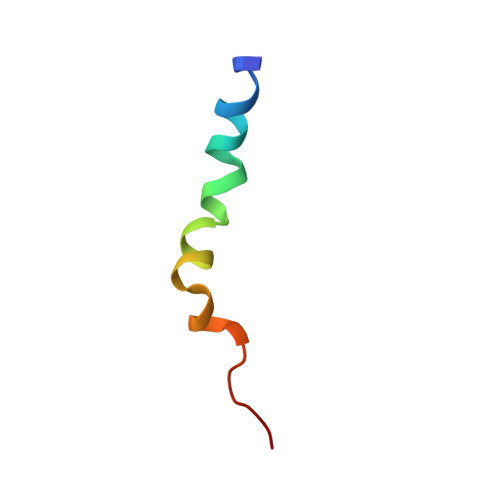NMR structure of the second intracellular loop of the alpha 2A adrenergic receptor: evidence for a novel cytoplasmic helix.
Chung, D.A., Zuiderweg, E.R., Fowler, C.B., Soyer, O.S., Mosberg, H.I., Neubig, R.R.(2002) Biochemistry 41: 3596-3604
- PubMed: 11888275
- DOI: https://doi.org/10.1021/bi015811+
- Primary Citation of Related Structures:
1HLL, 1HO9, 1HOD, 1HOF - PubMed Abstract:
A major, unresolved question in signal transduction by G protein coupled receptors (GPCRs) is to understand how, at atomic resolution, a GPCR activates a G protein. A step toward answering this question was made with the determination of the high-resolution structure of rhodopsin; we now know the intramolecular interactions that characterize the resting conformation of a GPCR. To what degree does this structure represent a structural paradigm for other GPCRs, especially at the cytoplasmic surface where GPCR-G protein interaction occurs and where the sequence homology is low among GPCRs? To address this question, we performed NMR studies on approximately 35-residue-long peptides including the critical second intracellular loop (i2) of the alpha 2A adrenergic receptor (AR) and of rhodopsin. To stabilize the secondary structure of the peptide termini, 4-12 residues from the adjacent transmembrane helices were included and structures determined in dodecylphosphocholine micelles. We also characterized the effects on an alpha 2A AR peptide of a D130I mutation in the conserved DRY motif. Our results show that in contrast to the L-shaped loop in the i2 of rhodopsin, the i2 of the alpha 2A AR is predominantly helical, supporting the hypothesis that there is structural diversity within GPCR intracellular loops. The D130I mutation subtly modulates the helical structure. The spacing of nonpolar residues in i2 with helical periodicity is a predictor of helical versus loop structure. These data should lead to more accurate models of the intracellular surface of GPCRs and of receptor-mediated G protein activation.
Organizational Affiliation:
Biophysics Research Division and Department of Pharmacology, The University of Michigan, Ann Arbor, Michigan 48109, USA.














